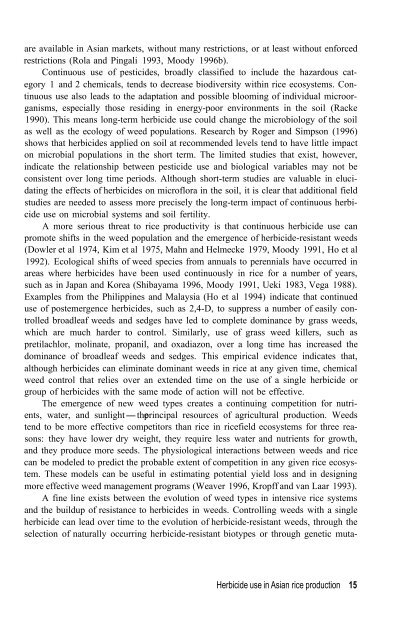HERBICIDES in Asian rice - IRRI books - International Rice ...
HERBICIDES in Asian rice - IRRI books - International Rice ...
HERBICIDES in Asian rice - IRRI books - International Rice ...
Create successful ePaper yourself
Turn your PDF publications into a flip-book with our unique Google optimized e-Paper software.
are available <strong>in</strong> <strong>Asian</strong> markets, without many restrictions, or at least without enforced<br />
restrictions (Rola and P<strong>in</strong>gali 1993, Moody 1996b).<br />
Cont<strong>in</strong>uous use of pesticides, broadly classified to <strong>in</strong>clude the hazardous category<br />
1 and 2 chemicals, tends to decrease biodiversity with<strong>in</strong> <strong>rice</strong> ecosystems. Cont<strong>in</strong>uous<br />
use also leads to the adaptation and possible bloom<strong>in</strong>g of <strong>in</strong>dividual microorganisms,<br />
especially those resid<strong>in</strong>g <strong>in</strong> energy-poor environments <strong>in</strong> the soil (Racke<br />
1990). This means long-term herbicide use could change the microbiology of the soil<br />
as well as the ecology of weed populations. Research by Roger and Simpson (1996)<br />
shows that herbicides applied on soil at recommended levels tend to have little impact<br />
on microbial populations <strong>in</strong> the short term. The limited studies that exist, however,<br />
<strong>in</strong>dicate the relationship between pesticide use and biological variables may not be<br />
consistent over long time periods. Although short-term studies are valuable <strong>in</strong> elucidat<strong>in</strong>g<br />
the effects of herbicides on microflora <strong>in</strong> the soil, it is clear that additional field<br />
studies are needed to assess more precisely the long-term impact of cont<strong>in</strong>uous herbicide<br />
use on microbial systems and soil fertility.<br />
A more serious threat to <strong>rice</strong> productivity is that cont<strong>in</strong>uous herbicide use can<br />
promote shifts <strong>in</strong> the weed population and the emergence of herbicide-resistant weeds<br />
(Dowler et al 1974, Kim et al 1975, Mahn and Helmecke 1979, Moody 1991, Ho et al<br />
1992). Ecological shifts of weed species from annuals to perennials have occurred <strong>in</strong><br />
areas where herbicides have been used cont<strong>in</strong>uously <strong>in</strong> <strong>rice</strong> for a number of years,<br />
such as <strong>in</strong> Japan and Korea (Shibayama 1996, Moody 1991, Ueki 1983, Vega 1988).<br />
Examples from the Philipp<strong>in</strong>es and Malaysia (Ho et al 1994) <strong>in</strong>dicate that cont<strong>in</strong>ued<br />
use of postemergence herbicides, such as 2,4-D, to suppress a number of easily controlled<br />
broadleaf weeds and sedges have led to complete dom<strong>in</strong>ance by grass weeds,<br />
which are much harder to control. Similarly, use of grass weed killers, such as<br />
pretilachlor, mol<strong>in</strong>ate, propanil, and oxadiazon, over a long time has <strong>in</strong>creased the<br />
dom<strong>in</strong>ance of broadleaf weeds and sedges. This empirical evidence <strong>in</strong>dicates that,<br />
although herbicides can elim<strong>in</strong>ate dom<strong>in</strong>ant weeds <strong>in</strong> <strong>rice</strong> at any given time, chemical<br />
weed control that relies over an extended time on the use of a s<strong>in</strong>gle herbicide or<br />
group of herbicides with the same mode of action will not be effective.<br />
The emergence of new weed types creates a cont<strong>in</strong>u<strong>in</strong>g competition for nutrients,<br />
water, and sunlight-the pr<strong>in</strong>cipal resources of agricultural production. Weeds<br />
tend to be more effective competitors than <strong>rice</strong> <strong>in</strong> <strong>rice</strong>field ecosystems for three reasons:<br />
they have lower dry weight, they require less water and nutrients for growth,<br />
and they produce more seeds. The physiological <strong>in</strong>teractions between weeds and <strong>rice</strong><br />
can be modeled to predict the probable extent of competition <strong>in</strong> any given <strong>rice</strong> ecosystem.<br />
These models can be useful <strong>in</strong> estimat<strong>in</strong>g potential yield loss and <strong>in</strong> design<strong>in</strong>g<br />
more effective weed management programs (Weaver 1996, Kropff and van Laar 1993).<br />
A f<strong>in</strong>e l<strong>in</strong>e exists between the evolution of weed types <strong>in</strong> <strong>in</strong>tensive <strong>rice</strong> systems<br />
and the buildup of resistance to herbicides <strong>in</strong> weeds. Controll<strong>in</strong>g weeds with a s<strong>in</strong>gle<br />
herbicide can lead over time to the evolution of herbicide-resistant weeds, through the<br />
selection of naturally occurr<strong>in</strong>g herbicide-resistant biotypes or through genetic muta-<br />
Herbicide use <strong>in</strong> <strong>Asian</strong> <strong>rice</strong> production 15

















